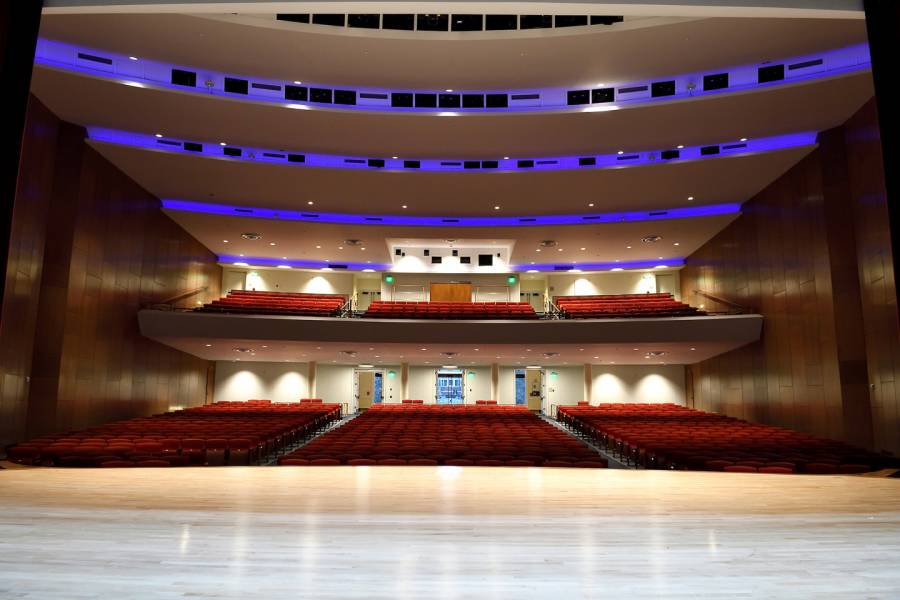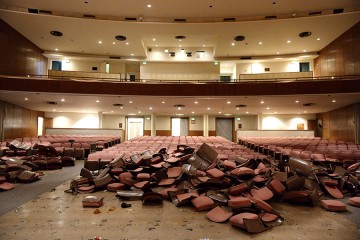Opening night is still weeks away, but the first reviews are already in: The renovation of Shriver Hall is a hit.
"I think it's going to make events here sparkle a little bit more," said Hopkins Symphony Orchestra violinist Colin McGregor, a junior.
Junior Tyrone Sumibcay agrees. He's a member of the Korean Pop Motion dance company and a Johns Hopkins University undergraduate admissions tour guide.
"I'm really excited to be able to share these new renovations with our prospective students and families," he said, "to really give them a good impression about all sorts of performances and student-run events that go on here on campus."
Video credit: Patrick Ridgely and Dave Schmelick
McGregor and Sumbicay were among a small number of student arts group members who recently got sneak peeks at the rejuvenated Shriver Hall auditorium.
"It looks very spacious, very modern. It looks a bit like the Meyerhoff Hall," first-year HSO violist Cindy Ow said, referring to the Baltimore Symphony's concert venue downtown. "It's a simple look, so it's, like, classic, a lot of wood."
Shriver Hall Auditorium opened in 1954 and has hosted performances by prodigies, lectures by Nobel laureates, and appearances by a president and presidential hopefuls. But it has been closed to concerts, recitals, speeches, ceremonies, admissions information sessions, and other events since September 2017.
The reason: The facility needed a facelift. Badly. The stage lighting and electrical system were aged and largely unworkable. Presenters sometimes brought in outside sound systems so their events could be heard. The acoustics weren't great. And, as most folks who sat in the audience remember, some seats were broken and pretty much all were uncomfortable.
"Shriver was not an aesthetically pleasing place," McGregor recalls. "Everything just felt very disconnected, and it felt a lot more like a high school auditorium than an elite university auditorium. … Literally, on the concert hall stage, we could not see our music."
That's no longer a problem. The $14 million renovation included full LED lighting systems for the stage and audience. A new stage floor and brighter finishes on both the ceiling and back wall also help consign to the past what Eclectics dance company co-president Daniel Bustos called the hall's former dark and "dingy" look.
"It looks more like an actual concert hall now, especially with all the light that they've added," said Bustos, a junior. "Just having lights makes the dance overall look better; it shapes the formations. It shapes how people look on the stage."
View photos of the new and improved Shriver Hall
And it's much more than just being able to see the performers, he said. The stage lighting system makes it possible for dance groups, in particular, to better express their artistry.
"Every piece has a story," Bustos said. "With lighting, you can really add and emphasize a certain theme that you want to sell to the audience. Based on certain tones or certain colors, you can add an emotion to a piece without just relying solely on the choreography."
Even before their first rehearsal Jan. 28, HSO musicians said the hall sounded more alive to them, acoustically. They also enjoyed checking out the wider, sturdier, and more comfortable audience seats and stretching their legs a bit more than past audience members were ever able to do.
Plenty of other improvements may not be as immediately obvious to performers and audiences, but will add to the quality of the Shriver experience. The floor is new. Above the hall, in mechanical spaces and on the roof, HVAC systems have been replaced to make the building warm in the winter and cool in the summer (not the other way around). Restrooms have been refreshed, and new ones will be added this summer. Fire alarms and sprinklers brought safety systems up to code.
There's a consolidated lighting and sound control station in the back of the balcony, a state-of-the-art sound system, a digital projection system, and a new movie screen. There's also a new rear projection system and secondary screen, which can be used to show images behind a performance onstage.
The Shriver Board Room, Clipper Room, and a first-floor classroom are redone. Outside, the formerly painted bricks on the front of the building have been stripped, new glass entry doors installed, windows repaired and repainted, fascia and trim repainted, and the building-topping cupola restored.
A first phase of improvements to the main lobby includes large wall panels with historical context about the murals throughout the room. The murals—required by building donor Alfred J. Shriver in his 1939 bequest and depicting, among other things, the university's first faculties, 10 Baltimore philanthropists, 10 "famous beauties of Baltimore," and Shriver's own Class of 1891—have been controversial since Shriver Hall opened.
The new panels—adapted from a booklet published by students in a university museum studies course—highlight the criticism. Student-written text points out some of the murals' inaccuracies, omissions, and misrepresentations of the university's and Baltimore's past.
More discussion of the Leon Kroll-painted murals is planned this semester. Before a second phase of lobby improvements begins this summer, the university will seek feedback from students, faculty, and staff about the future of the paintings.
A celebratory reopening of Shriver Hall, welcoming staff, faculty, and students, is scheduled for March 5 with remarks by JHU President Ronald J. Daniels, performances by several student groups, door prizes, and a surprise ending.
The Shriver Hall Concert Series makes its post-renovation debut in its namesake building on March 3 and the Hopkins Symphony returns to Shriver on March 9.
Posted in University News, Student Life
Tagged hopkins symphony orchestra, homewood campus, shriver hall concert series










